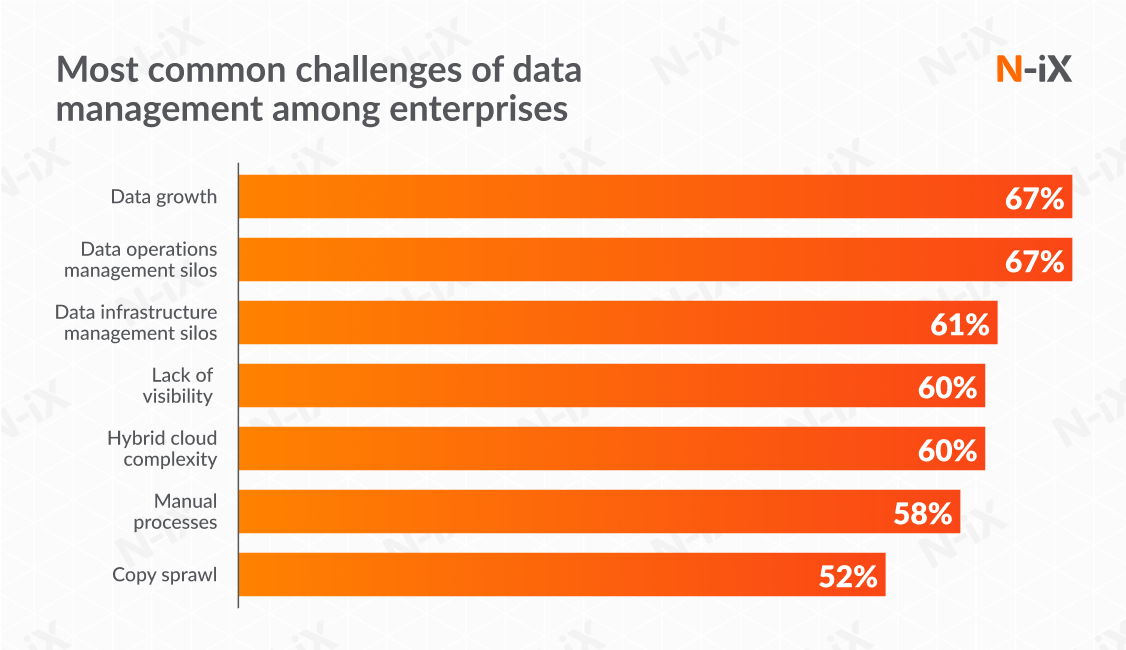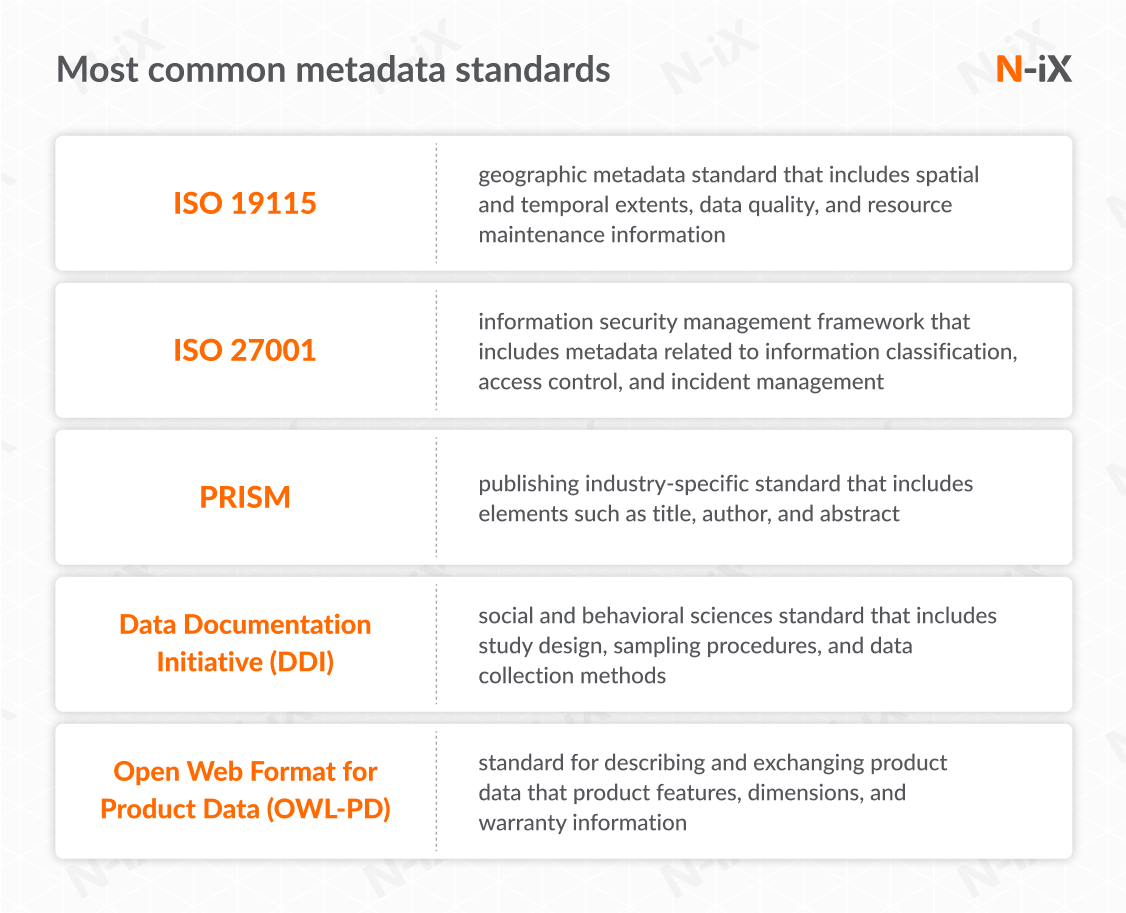According to Hewlett Packard's Data Innovations Guide, more than 50% of large enterprises need help managing the ever-growing volumes of data effectively. The main challenges include managing data growth (67%), dealing with data silos (67%), and lacking sufficient visibility (60%). Such obstacles can impede a company's progress, hinder innovation, and limit productivity.

One of the most effective ways of addressing these challenges is enterprise metadata management—a subset of data governance. What exactly is it, and how can it help your business? What challenges does it solve, and what best practices can you use to ensure successful implementation? Keep reading to find out.
What is enterprise metadata management?
Enterprise metadata management is a collection of processes and technologies aimed at surfacing, searching, classifying, and validating metadata obtained from an organization's various data sources. As the scope of metadata continues to expand, the range of elements it encompasses is increasing. A typical modern metadata stack can include the following:
- Technical metadata: database schemas and structural information, data sources, file names, geographic locations, etc.
- Business metadata: a glossary of business terms and their definitions, rules, restrictions, metrics, process flows, etc.
- Performance metadata: logs generated by cloud computing engines and data orchestration platforms, providing insights into system performance.
- Social metadata: collected from interactions between data consumers resulting from democratizing data.
- Usage metadata: logs from Business Intelligence tools, notebooks, and other applications, offering insights into how data is utilized.
- Governance metadata: collected through automatically classifying data assets based on various regulations such as PII, GDPR, etc.
Most common uses of enterprise metadata management
Now that we know what enterprise metadata management is, we need to understand how it can help your organization. Let's explore its four main applications.
Data classification
In most cases, it takes a lot of effort for multiple teams within an enterprise to collaborate on a single data asset (for example, an annual report) without exposing sensitive data to a breach. You have to take various additional measures to ensure security. These include setting up sophisticated staging areas, ETL pipelines, and manually written SQL queries.
Meanwhile, metadata management allows all organization members to access, explore, and comprehend data assets effortlessly. This approach enables more data users to uncover crucial business insights. It also helps drive effective decision-making without relying solely on experts with advanced technical proficiency.
Data discovery
The strategic value of metadata within an enterprise cannot be overstated. However, this valuable data is often scattered across various platforms, for example, Amazon S3 or MySQL. Enterprise metadata management can unify these data sources, enabling you to discover and access metadata regardless of location seamlessly. A metadata management solution then becomes the single source of truth that your advanced data analytics solutions can utilize to identify and analyze patterns or themes effectively.
Data lineage and governance
Data lineage helps understand the origins and evolution of your data throughout its lifecycle, making it a vital component of robust data governance. Organizations can automate data lineage activities using existing metadata, such as column descriptions and SQL codes, by implementing a metadata management solution. Such solutions eliminate the need for manual contextual information input in lineage diagrams, saving time and effort. Automated data lineage enables you to capture a broad data context that includes data sources, aggregation processes, quality indicators, and details about transformation. This, in turn, facilitates informed and effective business decision-making.
Data democratization
To achieve true data democratization, you must provide your teams with comprehensive visibility of all business data and the ability to incorporate it into their daily workflows. Without an easy way of making crucial business context accessible and actionable, onboarding new team members can become unnecessarily prolonged, often taking months to complete.
An enterprise metadata management platform offers end users access to relevant metadata directly within their tools. This approach simplifies the onboarding process for employees and makes integrating them into your organization easier.
3 challenges solved by managing your enterprise metadata
Now that we have learned how to apply it, let's try to understand why you need to do it. However, we will not dwell on the minor issues it can solve (and there are plenty). Instead, we will explore the large-scale challenges that many enterprises face.
Lack of visibility about stored, copied, and protected data
Enterprises that operate in hybrid environments need to streamline their data operations. The Hewlett-Packard study we mentioned earlier revealed that most organizations (68%) consider data management at scale as their top challenge in terms of data infrastructure. Moreover, 60% of organizations acknowledge that multiple tiers of storage silos make management even more complex.
A metadata management solution that harnesses comprehensive metadata about the company's data assets gives employees complete visibility into all data. It enables them to explore, discover, and leverage the information to improve the company's products or services. Metadata plays a vital role in ensuring that data context (what it means, its origins and quality, etc.) is preserved among the teams involved in data analysis.
Furthermore, enterprise metadata management can also play an essential role in identifying and unlocking new revenue opportunities that help you maximize the value of data. One such opportunity is monetizing anonymized data by providing it to organizations that can use it for business activities (for example, a transportation company offering anonymized data to traffic management authorities).
Lack of trust and limited accessibility
Operating within an unreliable system with data quality issues often leads to trust concerns among business users. These points of friction not only hinder their productivity but also cause frustration for all parties involved. The absence of proper management amplifies data reliability issues, making the problem even more severe. In some cases, users may struggle to retrieve the required data, making it not just a matter of data quality but overall accessibility. Effective metadata management is the vital link connecting vast volumes of data, offering the necessary comprehension of its context, meaning, and lineage.
Compliance with regulations and security standards
Meeting ever-growing regulatory requirements and achieving robust data governance poses challenges for numerous organizations. Modern data governance systems must provide data users with a flexible and highly automated framework to manage the structured lifecycle processes of data (creation, usage, and deletion).
This is precisely where enterprise metadata management is so helpful. It assists in consolidating intricate data relationships from diverse sources, leading to enhanced data governance that facilitates more accurate reporting and compliance.

How to ensure successful implementation of metadata management: top 6 best practices
As with any other data project, incorporating metadata management within your enterprise can be challenging. However, following these best practices will help you ensure the success of your project.
Outline goals and KPIs that align with your business objectives
To ensure successful implementation, it is crucial first to define goals and KPIs that align with your organization's vision. When outlining metadata management objectives, it is essential to set realistic expectations. These can be, for example, finding a scalable metadata management solution capable of cataloging a growing number of data sources or optimizing metadata management workloads to improve productivity and enable effective decision-making.
Similarly, setting relevant KPIs that align with your metadata management objectives is vital. For instance, if your goal is to improve productivity through metadata management, a suitable KPI could be tracking the number of implemented metadata-related policies and assessing their effectiveness.
Defining clear goals that you aim to achieve can be tricky. However, partnering with an experienced software engineering and consulting company can simplify this process.
At N-iX, for example, we help our partners set clear goals and KPIs through comprehensive Product Discovery. We can also apply our Technology Consulting expertise to create a straightforward implementation roadmap with time and cost estimates, team composition requirements, and more.
Define and establish a data governance strategy
Creating a data governance strategy is essential to provide clarity and purpose to your metadata management initiatives. Data governance is vital in aligning your organization's metadata management efforts with its business vision while supporting its goals and driving business value.
Moreover, a well-defined strategy outlines specific actions to accomplish the organization's objectives through effective governance. It includes establishing policies and procedures for data and metadata management, setting standards to ensure data quality and integrity, and defining clear roles and responsibilities for data management within the organization.
Create a skilled data team
Metadata management is not a one-time event or a static process. It is an ongoing, organization-wide endeavor that requires a dedicated metadata management team.
This team is responsible for formulating effective strategies and policies applicable across the organization. They collaborate with stakeholders from various departments to ensure everyone agrees and aligns with the metadata management workflows that match everyone's needs.
Finding the right experts to build such a team can be quite tricky. However, partnering with a software engineering company can be highly advantageous in overcoming this challenge. N-iX, for example, can effectively match your specific need. We can either efficiently identify suitable experts to extend your team or assemble a dedicated team to handle all aspects of enterprise metadata management for you.
Adopt metadata standards
The Dublin Core Metadata Element Set (DCMES) is the main metadata schema for describing data resources. It comprises fifteen core elements or properties that effectively define metadata, encompassing aspects like title, type, subject, creator, contributor, etc. Depending on your organization's activities and the industry it operates in, there are various other standards that you may need to comply with:
- ISO 19115: focuses on geographic metadata, encompassing elements like spatial and temporal extents, data quality, and resource maintenance information.
- ISO 27001: serves as an information security management framework and incorporates metadata elements related to information classification, access control, and incident management.
- PRISM: this standard developed specifically for the publishing industry includes title, author, abstract, and other elements.
- Data Documentation Initiative (DDI): designed for social and behavioral sciences and encompasses study design, sampling procedures, data collection methods, etc.
- Open Web Format for Product Data (OWL-PD): tailored for describing and exchanging product data and includes product features, dimensions, warranty information, etc.
By standardizing metadata, your organization will achieve compatibility across all diverse data sources. As a result, each stakeholder will understand how they can interact with the metadata, fostering effective collaboration.

Consider utilizing AI and Machine Learning (ML) to activate metadata
There are two types of metadata: passive and active. Passive or technical metadata encompasses different data types, schemas, and models. On the other hand, active metadata also includes descriptive metadata that provides enhanced context to data, such as operational, social, and business-related information.
Metadata collection and processing used to be focused primarily on passive metadata. However, with advancements in metadata management, modern systems can handle active or descriptive metadata, resulting in more efficient data pipelines and improved data discovery, compliance, and governance capabilities.
By harnessing AI and Machine Learning for both passive and active metadata, organizations can establish intelligent and dynamic workflows capable of conducting real-time predictive analysis and identifying patterns within the metadata. It empowers organizations to make more accurate decisions based on the insights derived from the metadata.
Deploy an effective management tool
Finally, having a reliable tool at your disposal to handle your metadata is essential. Relying solely on traditional metadata management that focuses on passive metadata is no longer an option for modern, data-driven organizations. Therefore, you need a solution that provides the following more advanced capabilities, such as:
- Data cataloging with straightforward data discovery.
- Autoscaling for efficient management of growing amounts of data.
- Visual query building for on-demand metadata extraction.
- Seamless integrations with data analysis and Business Intelligence platforms (Tableau, SQL, etc.).
- Comprehensive management of different types of both active and passive metadata.
What makes N-iX a reliable partner for successful enterprise metadata management implementation?
Since incorporating metadata management is far from trivial, especially without significant experience, it is highly recommended to partner with a company specializing in that sort of thing. Let's look at what N-iX brings to the table that will ensure the success of your project.
Deep data expertise
N-iX has a dedicated Data Unit that counts over 200 data experts proficient in various data services. These include Data Governance, AI and Machine Learning, enterprise metadata management and data governance, and more. We have delivered over 60 data projects for leading global enterprises and Fortune 500 companies.
Experience and global presence
The company has been delivering high-quality software solutions and engineering services for over 22 years. There are more than 2,400 experts at N-iX in 25 countries across Europe and the Americas.
Reliability and compliance
N-iX complies with all established data protection standards and regulations, such as GDPR and ISO 9001. Furthermore, we have established reliable business continuity plans and additional security measures to secure your data.
Have a question?
Speak to an expert



